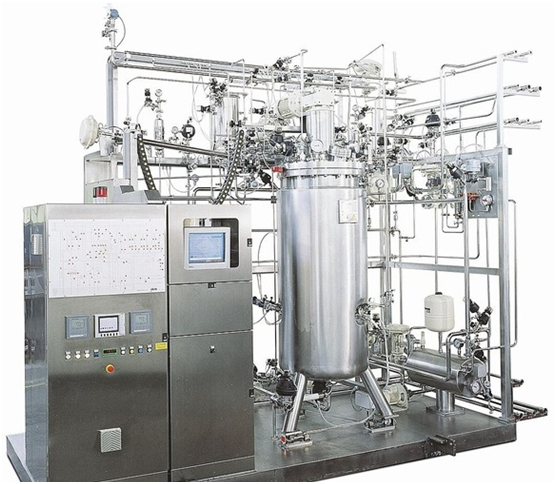MALTING STAGE
Malting is defined as a controlled partial germination of the cereal grain or barley. Malting helps to develop amylases and proteases in the barley. Malting is the first of the enzymatic process involved in beer production; and the enzymes that malting develops in the grains bring about the chemical conversions of all the complex molecules present in the malted grain s to the form it will be utilized by the growing yeast strain. It is noteworthy that the barley grains contain endogenous yeasts; and it is malting that helps to activate these endogenous yeasts present in the barley grains. Steeping, germination and kilning are all processes involved in malting. The enzymes produced from the germinated grains during malting (i.e. amylases and proteases) helps to convert the starch into fermentable sugars necessary for yeast growth.
STEEPING STAGE
Steeping is a malting technique in which the barley grains are soaked in water for about two days. The barley grains are usually soaked in a tank containing the water; and the water is later drained off after the steeping days are over. The water used for steeping is usually changed at intervals (about 6-8 hours) in order to keep the barley grains sweet. After steeping, the barley grains are overlaid on the malting floor and it is sprinkled with water to prevent drying out. The barley grains are usually partially germinated for about 3 days at 19oC. Regular aeration of the steeped grains will prevent the buildup of heat capable of damaging the embryo of the grains.
KILNING STAGE
Kilning is a malting technique that involves a controlled drying of the barley grains in hot air for about two days. Kilning helps to stop further enzymatic activity in the grains in such a manner that does not permanently affect the endogenous enzymes of the grains; and it also helps to promote the development of flavour. Kilning reduces the moisture content of the grains, thereby making it possible for the grains to be stored. It helps to produce friable and easily milled grains. And kilning also facilitates the rubbing off of the barley roots.
Kilning is not usually carried out at a very high temperature because high temperature may inhibit the enzymatic activity of the grains. The kilning temperatures are usually between 50-60oC and this temperature can be increased to 100oC depending on the type of beer to be brewed. Nevertheless, it is important to control and maintain the kilning temperatures at levels that allows for the maximal survival of the enzymes that will help to activate the mashing process.
MILLING STAGE
Milling is a technique used to crush the barley malt or grains in such a way that their husks are not completely removed. Milling is carried out on kiln-dried grains in a mill; and the grains are carefully grounded or milled. The grains can be milled into fine powders or milled in such a way that it is left in a coarse form with its husks still partially intact. Fine particles or powders of milled grains ensure adequate extract from the malt but they hinder filtration. But coarse particles with husks still partially intact favours filtration of the mash. The main purpose of milling is to expose the particles of the malt to the hydrolytic activity of malt enzymes during the next stage (mashing).
MASHING STAGE
Mashing is defined as the process in which the milled malted grains are mixed with water at an optimal temperature required for the hydrolytic enzymes to act on them. It is the actual stage at which the brewing process starts; and mashing determines the true nature of the wort. Mashing helps to release the sugary content of the cereal grains so that a soluble sugar solution will be formed for the actual fermentation process. This soluble sugar solution is known as wort. The major aim of mashing is to extract as much soluble portions of the malt as possible and to enzymatically hydrolyze insoluble portions of the malt and adjuncts.
Wort is defined as the aqueous solublesolutionthat results from the mashing process. Several factors affect the mashing process, and this include pH, temperature, duration of mashing and the extent of hydrolysis of starch and protein by the amylases and proteases respectively. There are many mashing methods employed in beer production but the most commonly used methods are infusion and decoction methods. In infusion methods, the mash is not boiled and the temperature is gradually raisedfrom a lower temperature to a higher temperature. But in decoction methods, part of the mash is transferred from the mash tun to the mash kettle where it is eventually boiled. At the end of mashing, the extract of the mash (i.e. the wort) is filtered off and separated from the remaining insoluble material such as the barley husks; and it is later sparged by adding hot water in order to start the next stage of brewing.
WORT BOILING AND COOLING STAGE
Wort boiling is another important aspect of brewing. The wort is moved into a large tank known as the cooking/lauter tun or boiling kettle. A lauter tun is the traditional vessel used for separation of the extracted wort. Thewort is boiled in this kettle, and hops and sometimes other ingredients such as herbs or sugars are usually added during the boiling process. The main essence of boiling the wort is to terminate enzymatic processes, precipitate proteins, isomerize hop resins, and concentrate and sterilize the wort.
The boiling also helps to extract the soluble substances from the hops. Hops add flavor, aroma and bitterness to the beer via its resins and essential oils. At the end of the wort boiling, the hopped wort settles to clarify using hop filters. And the hot wort is eventually cooled in a heat exchanger. The cooled wort is lacking in enzymes but it is very rich in sugar molecules necessary for fermentation. It is important to prevent any form of wort contamination during its transfer to the fermentation vessel.
FERMENTATION STAGE
Fermentation is the process during which the cooled wort is inoculated with the suitable yeasts depending on the type of beer to be produced. Saccharomyces cerevisiae and Saccharomyces carlsbergensis (Uvarum) are the two types of yeasts usually employed in beer production; and they are the microbes that are used to inoculate the cooled wort in the fermenter during fermentation processes. Beer production is produced via alcoholic fermentation – in which the substrate (in this case the cooled wort) is microbially converted to alcohol and carbondioxide. S. cerevisiae (which can also be called top fermenting yeast)is used for the production of stout or ale beer.
This yeast settles at the top of the fermenter at the end of fermentation; and thus the yeast is generally known as top fermenting yeast. S. carlsbergensis (which can also be called bottom fermenting yeast) is used for the production of lager beer. This yeast settles or flocculates at the bottom of the fermenter when the fermentation process is completed; and this is why it is known as bottom fermenting yeast. Ale beer or stout and lager beer are the two main types of beer. Ale is a fermented malt beverage that contains higher amounts of hop flavour than other beers; and it has a higher alcoholic content.
Lager beer is a beer which has been aged in tanks over a period of time. It is a much lighter type of beer than the ale beer. During fermentation, the fermentable sugars or wort is microbially converted to alcohol and carbondioxide (CO2); and fermentation processes last for some number of days – which is usually dependent on the type of beer produced. Heat is also formed during the fermentation process, and it is removed through cooling. This stage of fermentation is known as primary fermentation; and the yeasts settle at the top or bottom of the fermentation vessel depending on the type of beer being produced.
CONDITIONING/AGEING STAGE
Conditioning or ageing is the next stage after the primary fermentation process. At this stage, the beer obtained in the primary fermentation stage (which is usually greenish in colour) is known as green beer. The green beer has a harsh taste. Secondary fermentation is carried out at a low temperature on the green beer by priming it with sugars – which helps to improve the taste and appearance of the beer. Other important additives are also added in the fermentation vessel during this process. Once the beer is fully clarified, it is charged with CO2 gas prior to possible pasteurization and bottling. The addition of CO2 makes the beer to become carbonated; and this also enhances the taste of the beer as well as contributes to the characteristic foamy nature of the beer when poured into a cup.
PASTEURIZATION STAGE
Pasteurization is a sterilization technique that is used to heat milk and other liquids such as beer to destroy the microorganisms that can cause spoilage or disease. Beer may be pasteurized before bottling in order to remove any contaminating microorganisms. Sterile filters can also be used for sterilization of the beer in place of pasteurization.
BOTTLING/PACKAGING STAGE
Bottling is the final stage of the brewing process. The brewed beer is either packaged into bottles, cans or kegs. Bottling of beer is an intensive process, and several automated machines are used to achieve this process. This is the stage where the beer leaves the brewery to the open market for sale and consumption.
References
Bader F.G (1992). Evolution in fermentation facility design from antibiotics to recombinant proteins in Harnessing Biotechnology for the 21st century (eds. Ladisch, M.R. and Bose, A.) American Chemical Society, Washington DC. Pp. 228–231.
Nduka Okafor (2007). Modern industrial microbiology and biotechnology. First edition. Science Publishers, New Hampshire, USA.
Das H.K (2008). Textbook of Biotechnology. Third edition. Wiley-India ltd., New Delhi, India.
Latha C.D.S and Rao D.B (2007). Microbial Biotechnology. First edition. Discovery Publishing House (DPH), Darya Ganj, New Delhi, India.
Nester E.W, Anderson D.G, Roberts C.E and Nester M.T (2009). Microbiology: A Human Perspective. Sixth edition. McGraw-Hill Companies, Inc, New York, USA.
Steele D.B and Stowers M.D (1991). Techniques for the Selection of Industrially Important Microorganisms. Annual Review of Microbiology, 45:89-106.
Pelczar M.J Jr, Chan E.C.S, Krieg N.R (1993). Microbiology: Concepts and Applications. McGraw-Hill, USA.
Prescott L.M., Harley J.P and Klein D.A (2005). Microbiology. 6th ed. McGraw Hill Publishers, USA.
Steele D.B and Stowers M.D (1991). Techniques for the Selection of Industrially Important Microorganisms. Annual Review of Microbiology, 45:89-106.
Summers W.C (2000). History of microbiology. In Encyclopedia of microbiology, vol. 2, J. Lederberg, editor, 677–97. San Diego: Academic Press.
Talaro, Kathleen P (2005). Foundations in Microbiology. 5th edition. McGraw-Hill Companies Inc., New York, USA.
Thakur I.S (2010). Industrial Biotechnology: Problems and Remedies. First edition. I.K. International Pvt. Ltd. New Delhi, India.
Discover more from #1 Microbiology Resource Hub
Subscribe to get the latest posts to your email.



